THE HIGHLAND CLEARANCES |
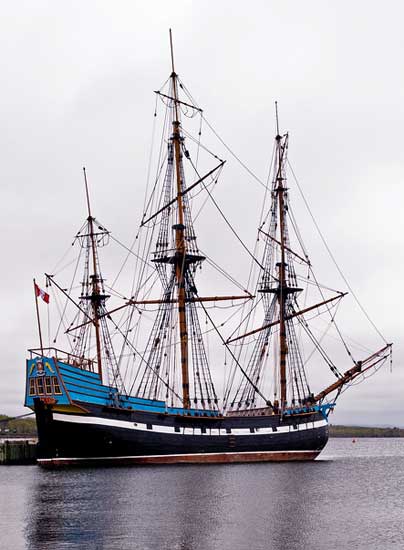 |
A brutal legacy of the late 18th and early 19th centuries is still etched in the minds of the people of the Highlands today.During what became known as the ''Highland Clearances'', tens of thousands of men, women and children were evicted, often violently, from their homes to make way for large scale sheep farming. The ship on the left The Hector, moored in Pictou, NS is a replica of the original which brought 200 Scots sailing from Ullapool, West Ross-Shire, Scotland in the Highlands arriving in Pictou, Nova Scotia on Sept. 15, 1773.
In some areas, whole glens were cleared, which today are as silent as they must have been when the landlord's factors had finished ruthlessly carrying out the orders of their masters. There were two distinct types of 'clearance'. The first was forced settlement on barren land usually near the sea. |
|
The crofts, as these plots of land became known, had very poor agricultural potential which the gentry wrongly assumed would be compensated for by fishing and seaweed harvesting, or kelping as it was called. The second type of 'clearance' was often prompted by the failure of the crofts to produce a living for the Highlanders. It was a hopeless situation for many. The sheer number of people pushed to the coast coupled with huge rent increases, over-fishing and over-kelping resulted in destitution and starvation. When, in 1846, the potato crop failed many were left with no alternative but to migrate south or emigrate to the colonies. In Knoydart, Ross, Skye, Tiree and most notably in the vast tracts of land in Sutherland owned by Elizabeth, Countess of Sutherland, the clearances were particularly noted for the violence used. Two of the most notorious evictors were James Loch and Patrick Sellar. Around 1820 demand for kelp and cattle dwindled and many tenants sank into rent arrears and apathy. In turn the rise in number of those unable to pay their rent encouraged landowners to evict the tenants from the marginal land leaving emigration as the only alternative. Lord MacDonald alone cleared most of North Uist and Skye or sold out to the infamous John Gordon of Cluny. Even today, generations after the last Highlanders set sail aboard wooden sailing ships at Ullapool and other ports on the west coast, never again to see the mountains and glens of home, the arguments still rage. There is no question that many Highlanders were betrayed by their clan chiefs and imported English noblemen. The utter disregard for the life of a proud people inflamed passions then, as it still does. Much of the land is still owned by the same families and sheep are still farmed where people once lived. During 1995, a campaign began to remove a statue of the notorious 1st Duke of Sutherland, which dominates the hills and skyline above the small east coast town of Golspie, replacing it with a more fitting memorial to the victims of the Clearances. Whether that will ever happen remains to be seen. But it is worth recalling that when the factor called by after the Duke's death in 1833, those tenants allowed to remain on the Sutherland estates were asked to contribute to the costs of raising the monument. They knew they had a choice - pay up or face the threat of eviction, hence the reason for them being described as ''grateful tenants'' in the inscription on the statue's plinth. The English have great difficulty in understanding the Nationalist mindset, perhaps, like the Japanese, they do not teach the distasteful parts of their imperial history to their children. That in itself speaks volumes. |
| This History Lesson Was Brought To You By Our Friends @ HIGHLANDER WEB MAGAZINE |
 |
Clearing The Air On The Clearances |
BEN MCCONVILLE |
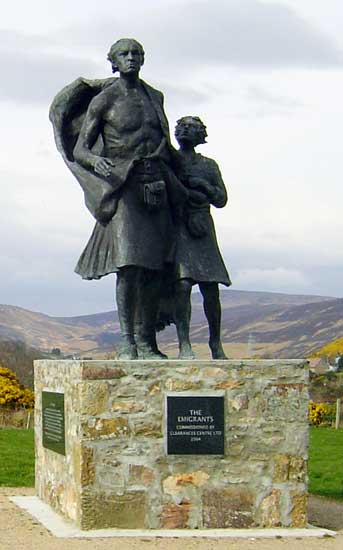 |
During the period 1785 to 1886, when th Crofters Act was passed, it is estimated that about 500,000 Highlanders left their homes in search of a new life. Some were forcibly evicted in the most brutal circumstances, others left of their own volition. But the debate in post-devolution Scotland now rages on what were the social and economic factors that led to so many Highlanders seeking a life elsewhere. A compelling contemporaneous account of the Clearances was written by Alexander Mackenzie in 1883. Mackenzie was the editor of Celtic Magazine and although he was born too late for the height of the Clearances, he witnessed the trials of the Braes Crofters who had revolted against being removed and was a witness to the Glendale Revolt. He spoke to many witnesses who told of the miserable conditions of those cleared from their homes. Using various earlier texts, Mackenzie documents a number of incidents recounted by those who witnessed the deaths of the vulnerable young and old who could not survive the harsh conditions many crofters found themselves in when forced off the land. A different first-hand version of events was offered by James Loch, a notorious factor for Lady Sutherland, who, in his book An Account of the Sutherland Improvements published in 1815, described the Clearances as progress. The land could no longer sustain its population and the lairds did their best for the people, often paying for their passage to the New World, although many crossed the sea as indentured servants bound for America, Canada or Australia. However, the Duke of Sutherland cleared 15,000 people from his land to make way for 200,000 sheep. Evictions at the rate of 2,000 families in one day were not uncommon. Many starved and froze to death where their homes had once stood. |
The first modern overview of the period was written 40 years ago by John Prebble. A popular historian, his book The Highland Clearances describes how the chiefs lost their powers in the late 18th century after the Jacobite uprising was crushed. |
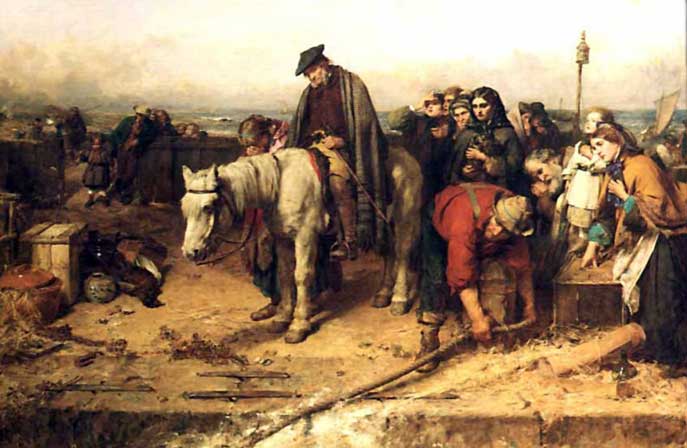 |
Tom Devine, author and noted professor of Irish and Scottish Studies at Aberdeen University, believes the same fate befell rural communities across Scotland and that Lowlanders too were cleared off the land. He says populations were also removed by stealth. And so say all of us Kate!!! |
 |
EYE WITNESS ACCOUNTS |
Adapted from "Highland Clearances - An Introduction" by Steve Blamires |
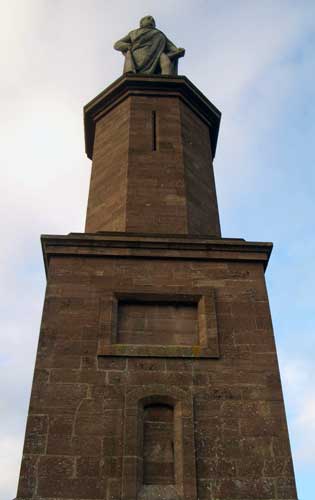 |
The actions of Patick Sellar and James Loch would in themelves fill a book - and, indeed have already done so. Sellar was not the only Sutherland estate factor but was also a sheep farmer who had a personal interest in clearing as many of the people on the estate as he could in order to increase the size of his own flock. His methods were the most brutal of all recorded. We will never know about the hundreds of thousands which were never recorded. A few examples of Sellar's handiwork follow: In one instance a pregnant woman by the name of Rayigill MacKay climbed on to her roof in an attempt to save some of the timbers which Sellar had torched in order to make a shelter for the baby to be. She fell through the burning heather thatch, went into premature labour and lost the child. Sellar turned and left her there in that pitiful condition. Donald MacBeath was lying incapacitated due to high fever when Sellar and his squad arrived. They could not get him to rise and leave his home while they burned the timbers so instead they tore the roof off the little croft and left the ailing MacBeath to lie unprotected from the wind and rain. He died five days later. William Chisholm appealed to Sellar not to burn his house down as his hundred year old mother was lying inside. Sellar's reply was, "Damn her, the old witch, she has lived too long, let her burn." and personally torched the dry heather thatch. The very blankets upon which she lay were aflame by the time William managed to pull her from the burning cottage. She was laid in an uncovered cow shed where she later died. In 1816 Sellar was eventually brought to trial on charges of culpable homicide and willful fire raising. The whole trial was a farce as the judges and court officials were all the landed gentry and despite the |
volume of evidence against him he was acquitted of all charges, In an act of vengeance he returned to Sutherlandshire and burned down another forty houses. These houses were all on land which had been given to one of the in-coming sheep farmers, 7,000 acres of it and he had made it clear to Sellar that the tenant farmers were not in the way of his sheep and they did not need to be moved at all. Sellar burned their homes and possessions anyway and left them to freeze to death or board one of the coffin ships leaving for Canada or America. Eye-witness accounts of other Clearances are: - In 1819 an old lady who had been Cleared made the journey back to where her home used to be. On return a neighbour asked her what she saw. She replied after a long silence, "I saw a raven's nest in the chimney of your own ruined house and I saw the minister's study turned into a kennel for dogs." 1821 Sutherland commented, "Strathbora is now effectually Cleared of all its turbulent people. The removings were completed on Friday night and the houses demolished without a single word. Some are off for Caithness but the bulk of them seem to have a wish to go to America. We are now I think settled for a few years." Later a visitor to the same area immediately after this Clearance commented, "All was silence and desolation. Blackened and roofless huts, still enveloped in smoke - articles of furniture cast away, as of no value to the houseless - and a few domestic fowls, scraping for food among the hills of ashes, were the only objects that told us of man. A few days had sufficed to change a countryside, teeming with the cheeriest sounds of rural life, into a desert." 1829 Beriah Botfield wrote, "Returning to Golspie we witnessed the melancholy spectacle of a flock of men, women and children, of all ages, hasting in their holiday attire, to embark onboard a brig from Brora, to Upper Canada, all more or less disatisfied with the new order of things, which the presiding genius of the Marchioness of Stafford has caused to spring in an incredibly short period of time, out of the relics of the barbaric feudal system." 1853 Evictions in Knoydart, "Several refused to emigrate and took refuge in caves, gravel pits or hovels made in the ruins of their former dwellings. They were miserably clad, having no change of raiment, and their food was limited to potatos." Later reports stated that most ended up "packed off like so many African slaves to the Cuban market." 1853 At Suishnish in Skye 32 families, 150 people, were Cleared three times - 1849, 1852 and 1853. One account told of how the buildings were destroyed and, "It was a time of snow, and one man who had returned to his home in Suishnish, was found dead the following morning at the door of his ruined house, having perished in the night from exposure and cold." Many of those Cleared were in their 80s and 90s. One lady of 96 was turned out into the snow, her home burned down, and left homeless for several weeks. The officer performing the evictions and burnings was also the local poor Law Inspector. Another eye-witness acount states that one of the Cleared families had moved into, "a wretched hovel, unfit for sheep or pigs. Here 6 human beings had to take shelter. There was no room for a bed so they all lay down to rest on the bare floor. On Wednesday last the head of the wretched family, William Matheson, a widower, took ill and expired on the following Sunday. His family consisted of an aged mother, 96, and his own four children - John 17, Alex 14, William 11 and Peggy 9 - the old woman was lying-in and when a brother-in-law of Matheson called to see how he was, he was horror struck to find Matheson lying dead on the same pallet of straw on which the old woman rested; and there also lay his two children, Alexander and Peggy, sick! Those who witnessed this scene declared that a more heart-rending scene they never witnessed. Matheson's corpse was removed as soon as possile; but the scene is still more deplorable. Here, in this wretched abode, and abode not fit at all for human beings, is an old woman of 96, stretched on the cold ground with two of her granchildren lying sick, one on each side of her." 1854 Archibald Geike, Scottish Reminiscences (Glasgow 1906), described a Clearance in 1854 on Skye "...one afternoon, as I was returning from my ramble, a strange wailing sound reached my ears at intervals on the breeze from the west. On gaining the top of one of the hills on the south side of the valley, I could see a long and motley procession winding along the road that lead north from Suishnish. It halted at the point of the road opposite Kilbride, and there the lamentation became long and loud. As I drew nearer, I could see that the minister with his wife and daughters had come out to meet the people and bid them all farewell. It was a miscellaneous gathering of at least three generations of crofters. There were old men and women, too feeble to walk, who were placed in carts; the younger members of the community on foot were carrying their bundles of clothes and household effects, while the children, with looks of alarm, walked alongside. There was a pause in the notes of woe as a last word was exchanged with the family of Kilbride. Everyone was in tears; each wished to clasp the hands that had so often be-friended them, and it seemed as if they could not tear themselves away. When they set forth once more, a cry of grief went up to heaven, the long plaintive wail, like a funeral coronach, was resumed, and after the last of the emigrants had disappeared behind the hill, the sound seemed to re-echo through the whole valley of strath in one prolonged note of desolation. The people were on their way to be shipped to Canada." 1862 Eye-witness account, "The factor, that dreaded middleman of the people, came with the underlings of the law, with spade and with pick-axe, and left literally not one stone upon another of the poor cottages standing. I can see a miserable hovel into which several families have crowded, who had not long before separate holdings of their own." |
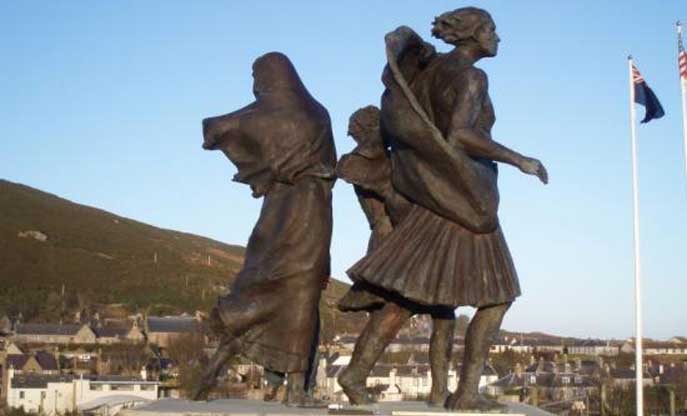 |
We'd Like To Thank Steve Blamires & CLANNADA na GADELICA For This History Lesson |
Read The Whole Steve Blamires Brilliant Article HERE |
 |
© Paisley Tartan Army 2008-09
